Policy, Power and Politics in Healthcare
VerifiedAdded on 2022/11/26
|14
|3898
|498
AI Summary
This document analyzes the Australian National Breastfeeding Strategy for the years 2010-2015. It discusses the significance of breastfeeding, the declining rates, and the reasons behind it. The document also explores the objectives, goals, and alternative strategies to promote breastfeeding. It emphasizes the importance of monitoring the policy interventions and considering social norms, cultural, and environmental factors in promoting breastfeeding.
Contribute Materials
Your contribution can guide someone’s learning journey. Share your
documents today.
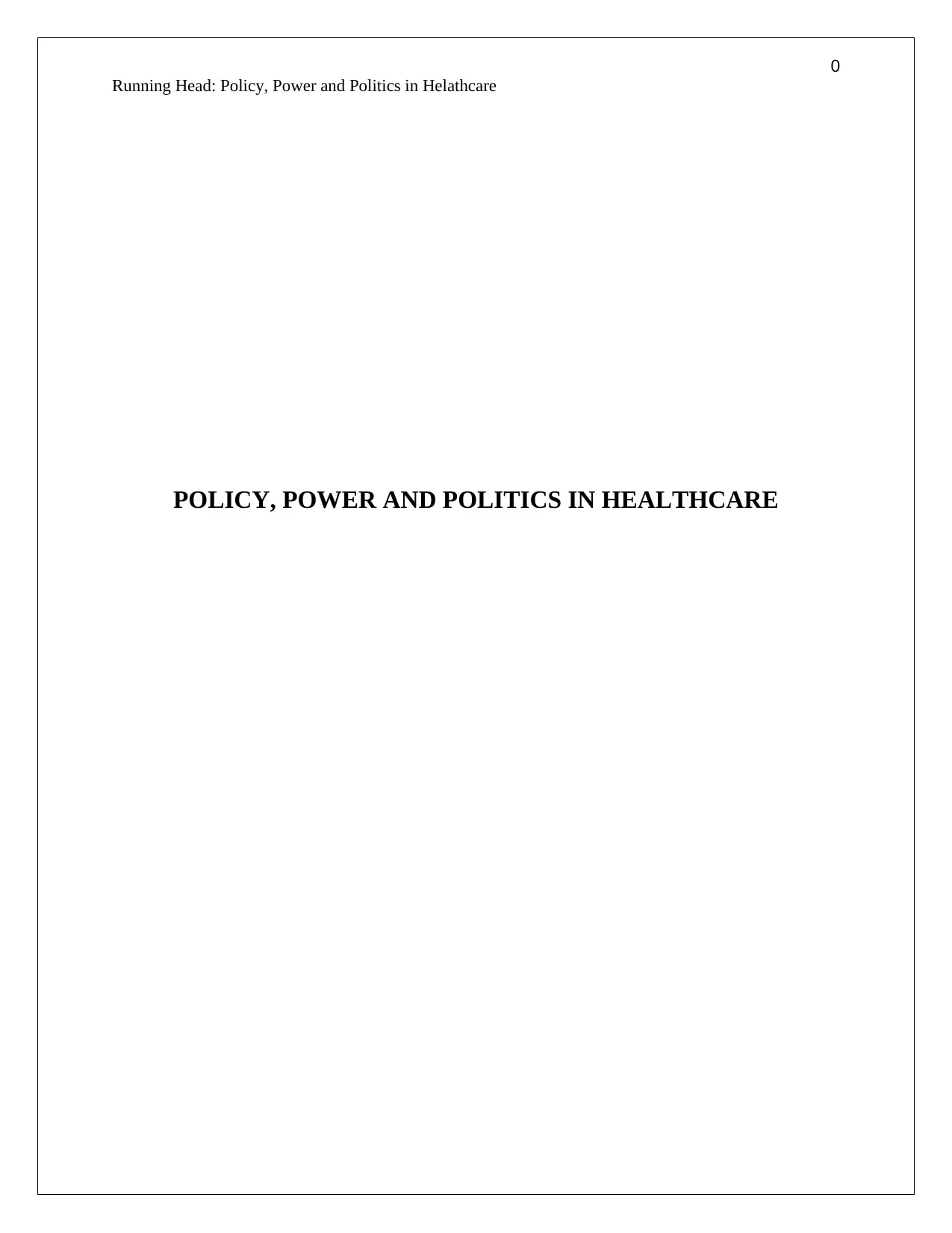
0
Running Head: Policy, Power and Politics in Helathcare
POLICY, POWER AND POLITICS IN HEALTHCARE
Running Head: Policy, Power and Politics in Helathcare
POLICY, POWER AND POLITICS IN HEALTHCARE
Secure Best Marks with AI Grader
Need help grading? Try our AI Grader for instant feedback on your assignments.
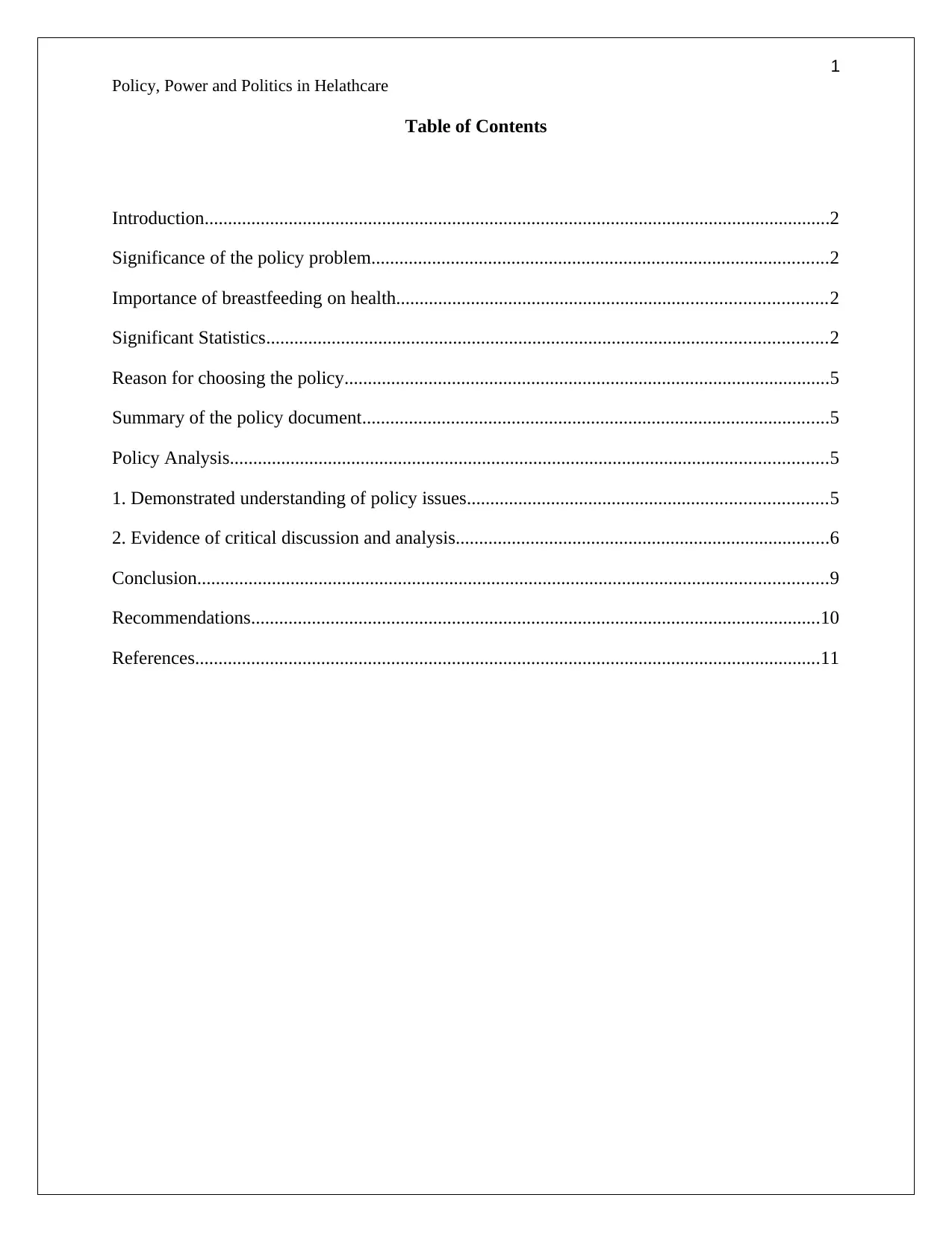
1
Policy, Power and Politics in Helathcare
Table of Contents
Introduction......................................................................................................................................2
Significance of the policy problem..................................................................................................2
Importance of breastfeeding on health............................................................................................2
Significant Statistics........................................................................................................................2
Reason for choosing the policy........................................................................................................5
Summary of the policy document....................................................................................................5
Policy Analysis................................................................................................................................5
1. Demonstrated understanding of policy issues.............................................................................5
2. Evidence of critical discussion and analysis................................................................................6
Conclusion.......................................................................................................................................9
Recommendations..........................................................................................................................10
References......................................................................................................................................11
Policy, Power and Politics in Helathcare
Table of Contents
Introduction......................................................................................................................................2
Significance of the policy problem..................................................................................................2
Importance of breastfeeding on health............................................................................................2
Significant Statistics........................................................................................................................2
Reason for choosing the policy........................................................................................................5
Summary of the policy document....................................................................................................5
Policy Analysis................................................................................................................................5
1. Demonstrated understanding of policy issues.............................................................................5
2. Evidence of critical discussion and analysis................................................................................6
Conclusion.......................................................................................................................................9
Recommendations..........................................................................................................................10
References......................................................................................................................................11
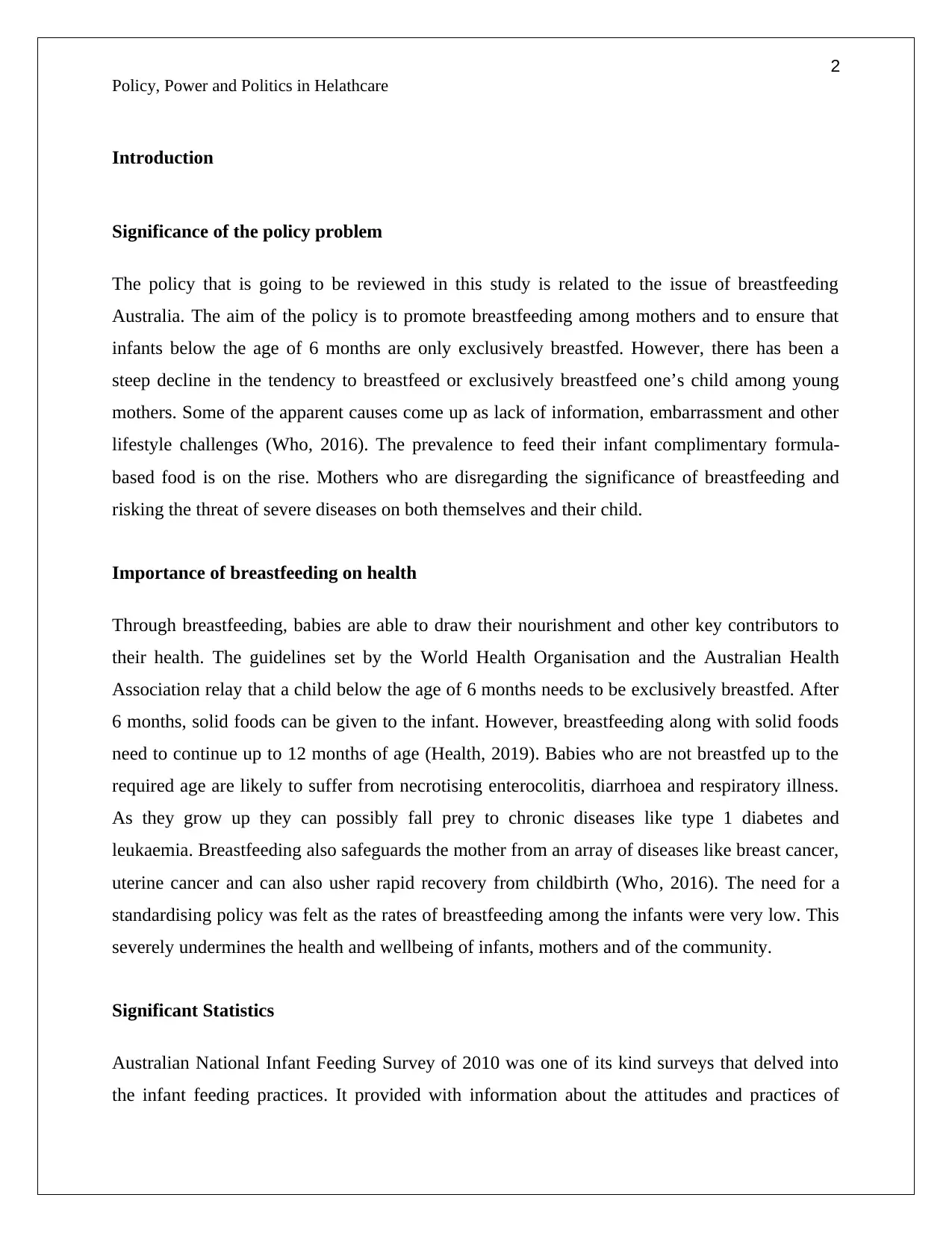
2
Policy, Power and Politics in Helathcare
Introduction
Significance of the policy problem
The policy that is going to be reviewed in this study is related to the issue of breastfeeding
Australia. The aim of the policy is to promote breastfeeding among mothers and to ensure that
infants below the age of 6 months are only exclusively breastfed. However, there has been a
steep decline in the tendency to breastfeed or exclusively breastfeed one’s child among young
mothers. Some of the apparent causes come up as lack of information, embarrassment and other
lifestyle challenges (Who, 2016). The prevalence to feed their infant complimentary formula-
based food is on the rise. Mothers who are disregarding the significance of breastfeeding and
risking the threat of severe diseases on both themselves and their child.
Importance of breastfeeding on health
Through breastfeeding, babies are able to draw their nourishment and other key contributors to
their health. The guidelines set by the World Health Organisation and the Australian Health
Association relay that a child below the age of 6 months needs to be exclusively breastfed. After
6 months, solid foods can be given to the infant. However, breastfeeding along with solid foods
need to continue up to 12 months of age (Health, 2019). Babies who are not breastfed up to the
required age are likely to suffer from necrotising enterocolitis, diarrhoea and respiratory illness.
As they grow up they can possibly fall prey to chronic diseases like type 1 diabetes and
leukaemia. Breastfeeding also safeguards the mother from an array of diseases like breast cancer,
uterine cancer and can also usher rapid recovery from childbirth (Who, 2016). The need for a
standardising policy was felt as the rates of breastfeeding among the infants were very low. This
severely undermines the health and wellbeing of infants, mothers and of the community.
Significant Statistics
Australian National Infant Feeding Survey of 2010 was one of its kind surveys that delved into
the infant feeding practices. It provided with information about the attitudes and practices of
Policy, Power and Politics in Helathcare
Introduction
Significance of the policy problem
The policy that is going to be reviewed in this study is related to the issue of breastfeeding
Australia. The aim of the policy is to promote breastfeeding among mothers and to ensure that
infants below the age of 6 months are only exclusively breastfed. However, there has been a
steep decline in the tendency to breastfeed or exclusively breastfeed one’s child among young
mothers. Some of the apparent causes come up as lack of information, embarrassment and other
lifestyle challenges (Who, 2016). The prevalence to feed their infant complimentary formula-
based food is on the rise. Mothers who are disregarding the significance of breastfeeding and
risking the threat of severe diseases on both themselves and their child.
Importance of breastfeeding on health
Through breastfeeding, babies are able to draw their nourishment and other key contributors to
their health. The guidelines set by the World Health Organisation and the Australian Health
Association relay that a child below the age of 6 months needs to be exclusively breastfed. After
6 months, solid foods can be given to the infant. However, breastfeeding along with solid foods
need to continue up to 12 months of age (Health, 2019). Babies who are not breastfed up to the
required age are likely to suffer from necrotising enterocolitis, diarrhoea and respiratory illness.
As they grow up they can possibly fall prey to chronic diseases like type 1 diabetes and
leukaemia. Breastfeeding also safeguards the mother from an array of diseases like breast cancer,
uterine cancer and can also usher rapid recovery from childbirth (Who, 2016). The need for a
standardising policy was felt as the rates of breastfeeding among the infants were very low. This
severely undermines the health and wellbeing of infants, mothers and of the community.
Significant Statistics
Australian National Infant Feeding Survey of 2010 was one of its kind surveys that delved into
the infant feeding practices. It provided with information about the attitudes and practices of
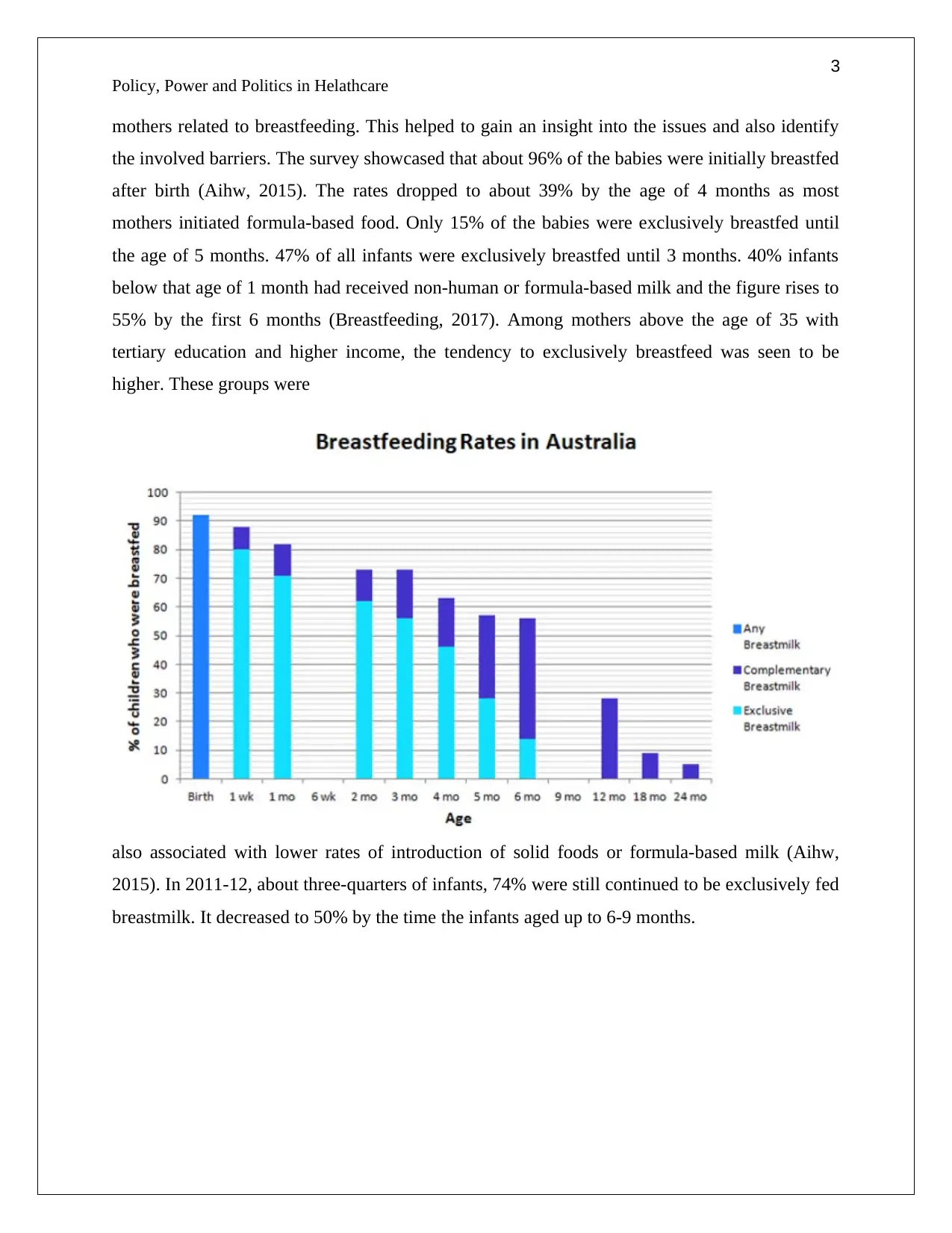
3
Policy, Power and Politics in Helathcare
mothers related to breastfeeding. This helped to gain an insight into the issues and also identify
the involved barriers. The survey showcased that about 96% of the babies were initially breastfed
after birth (Aihw, 2015). The rates dropped to about 39% by the age of 4 months as most
mothers initiated formula-based food. Only 15% of the babies were exclusively breastfed until
the age of 5 months. 47% of all infants were exclusively breastfed until 3 months. 40% infants
below that age of 1 month had received non-human or formula-based milk and the figure rises to
55% by the first 6 months (Breastfeeding, 2017). Among mothers above the age of 35 with
tertiary education and higher income, the tendency to exclusively breastfeed was seen to be
higher. These groups were
also associated with lower rates of introduction of solid foods or formula-based milk (Aihw,
2015). In 2011-12, about three-quarters of infants, 74% were still continued to be exclusively fed
breastmilk. It decreased to 50% by the time the infants aged up to 6-9 months.
Policy, Power and Politics in Helathcare
mothers related to breastfeeding. This helped to gain an insight into the issues and also identify
the involved barriers. The survey showcased that about 96% of the babies were initially breastfed
after birth (Aihw, 2015). The rates dropped to about 39% by the age of 4 months as most
mothers initiated formula-based food. Only 15% of the babies were exclusively breastfed until
the age of 5 months. 47% of all infants were exclusively breastfed until 3 months. 40% infants
below that age of 1 month had received non-human or formula-based milk and the figure rises to
55% by the first 6 months (Breastfeeding, 2017). Among mothers above the age of 35 with
tertiary education and higher income, the tendency to exclusively breastfeed was seen to be
higher. These groups were
also associated with lower rates of introduction of solid foods or formula-based milk (Aihw,
2015). In 2011-12, about three-quarters of infants, 74% were still continued to be exclusively fed
breastmilk. It decreased to 50% by the time the infants aged up to 6-9 months.
Secure Best Marks with AI Grader
Need help grading? Try our AI Grader for instant feedback on your assignments.
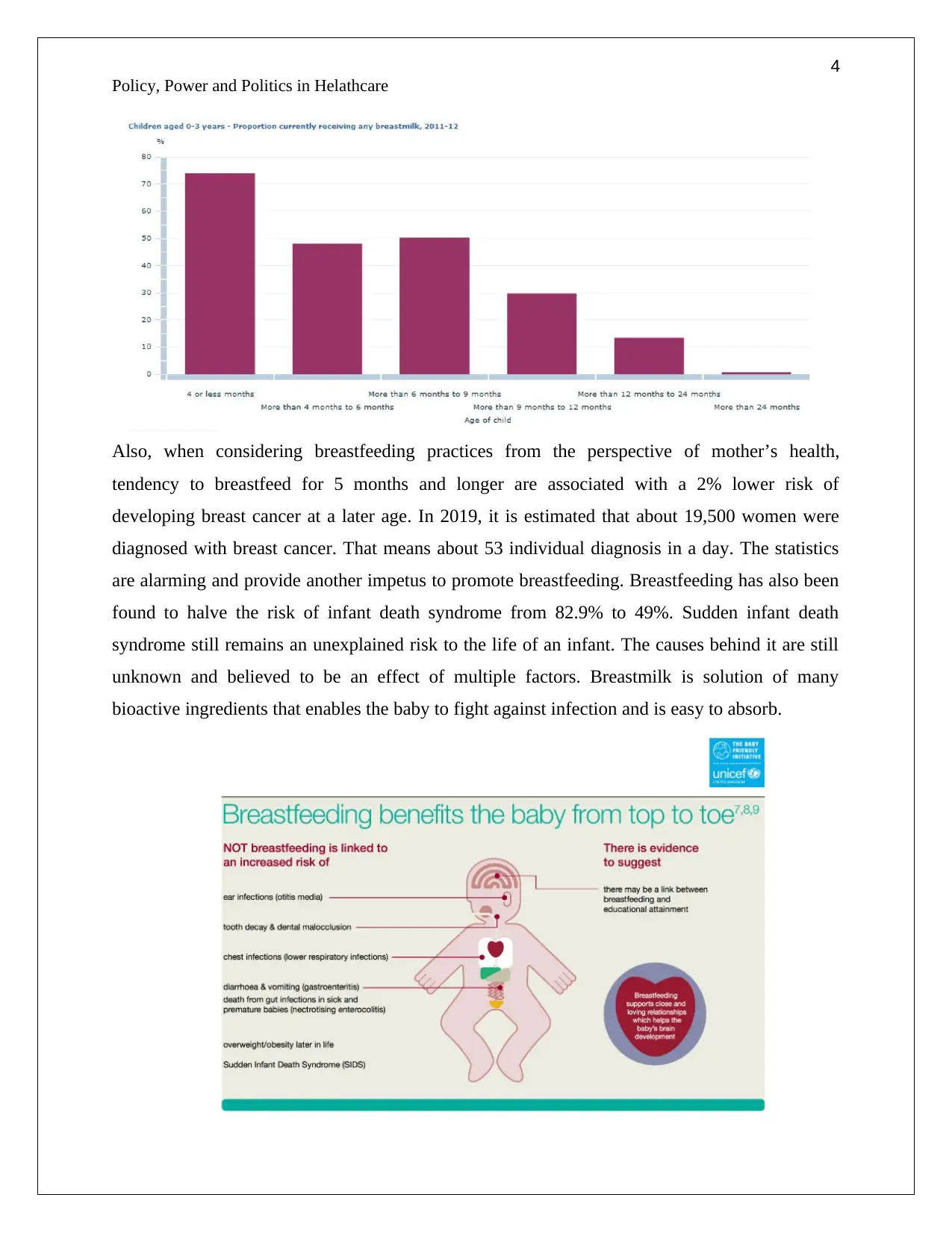
4
Policy, Power and Politics in Helathcare
Also, when considering breastfeeding practices from the perspective of mother’s health,
tendency to breastfeed for 5 months and longer are associated with a 2% lower risk of
developing breast cancer at a later age. In 2019, it is estimated that about 19,500 women were
diagnosed with breast cancer. That means about 53 individual diagnosis in a day. The statistics
are alarming and provide another impetus to promote breastfeeding. Breastfeeding has also been
found to halve the risk of infant death syndrome from 82.9% to 49%. Sudden infant death
syndrome still remains an unexplained risk to the life of an infant. The causes behind it are still
unknown and believed to be an effect of multiple factors. Breastmilk is solution of many
bioactive ingredients that enables the baby to fight against infection and is easy to absorb.
Policy, Power and Politics in Helathcare
Also, when considering breastfeeding practices from the perspective of mother’s health,
tendency to breastfeed for 5 months and longer are associated with a 2% lower risk of
developing breast cancer at a later age. In 2019, it is estimated that about 19,500 women were
diagnosed with breast cancer. That means about 53 individual diagnosis in a day. The statistics
are alarming and provide another impetus to promote breastfeeding. Breastfeeding has also been
found to halve the risk of infant death syndrome from 82.9% to 49%. Sudden infant death
syndrome still remains an unexplained risk to the life of an infant. The causes behind it are still
unknown and believed to be an effect of multiple factors. Breastmilk is solution of many
bioactive ingredients that enables the baby to fight against infection and is easy to absorb.
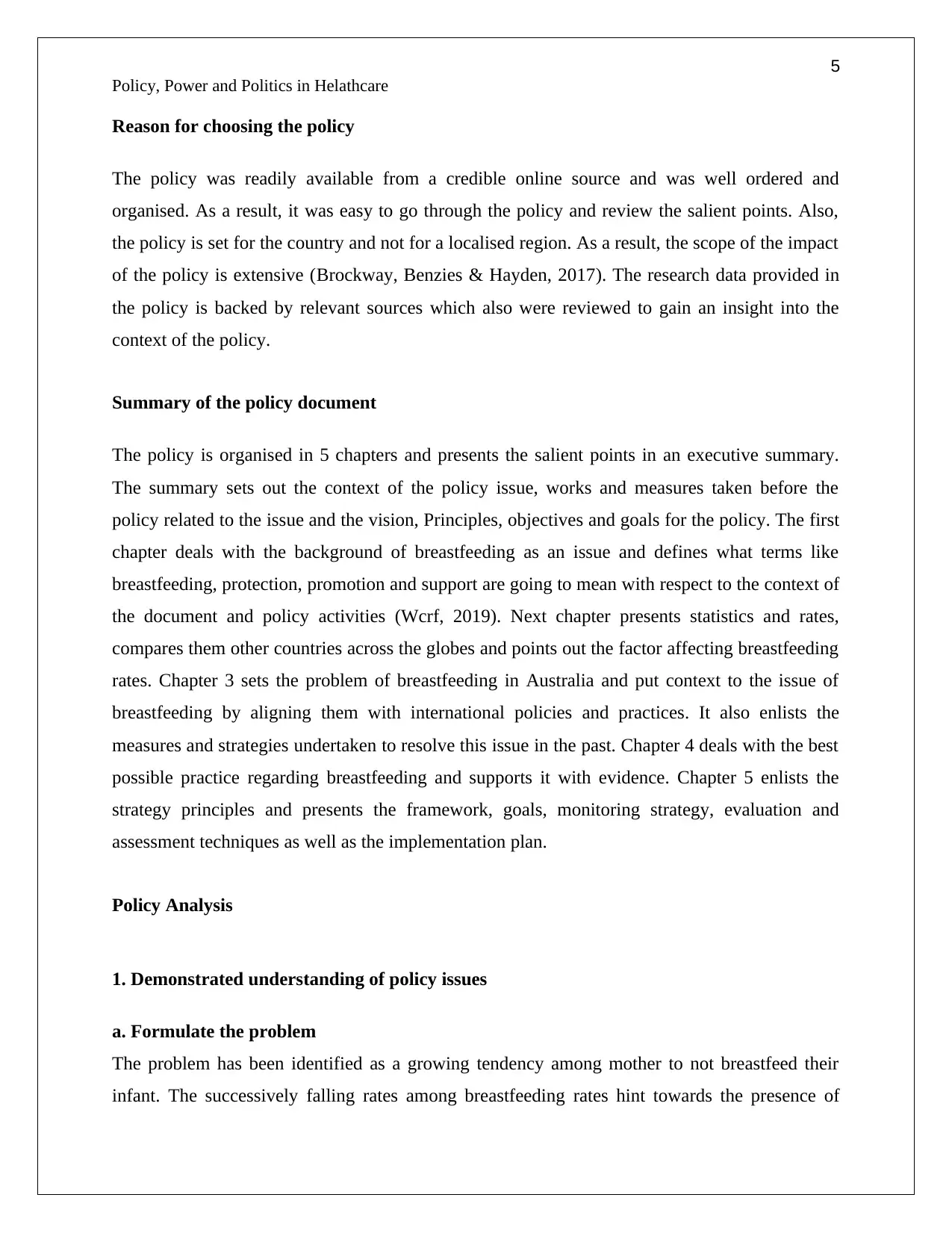
5
Policy, Power and Politics in Helathcare
Reason for choosing the policy
The policy was readily available from a credible online source and was well ordered and
organised. As a result, it was easy to go through the policy and review the salient points. Also,
the policy is set for the country and not for a localised region. As a result, the scope of the impact
of the policy is extensive (Brockway, Benzies & Hayden, 2017). The research data provided in
the policy is backed by relevant sources which also were reviewed to gain an insight into the
context of the policy.
Summary of the policy document
The policy is organised in 5 chapters and presents the salient points in an executive summary.
The summary sets out the context of the policy issue, works and measures taken before the
policy related to the issue and the vision, Principles, objectives and goals for the policy. The first
chapter deals with the background of breastfeeding as an issue and defines what terms like
breastfeeding, protection, promotion and support are going to mean with respect to the context of
the document and policy activities (Wcrf, 2019). Next chapter presents statistics and rates,
compares them other countries across the globes and points out the factor affecting breastfeeding
rates. Chapter 3 sets the problem of breastfeeding in Australia and put context to the issue of
breastfeeding by aligning them with international policies and practices. It also enlists the
measures and strategies undertaken to resolve this issue in the past. Chapter 4 deals with the best
possible practice regarding breastfeeding and supports it with evidence. Chapter 5 enlists the
strategy principles and presents the framework, goals, monitoring strategy, evaluation and
assessment techniques as well as the implementation plan.
Policy Analysis
1. Demonstrated understanding of policy issues
a. Formulate the problem
The problem has been identified as a growing tendency among mother to not breastfeed their
infant. The successively falling rates among breastfeeding rates hint towards the presence of
Policy, Power and Politics in Helathcare
Reason for choosing the policy
The policy was readily available from a credible online source and was well ordered and
organised. As a result, it was easy to go through the policy and review the salient points. Also,
the policy is set for the country and not for a localised region. As a result, the scope of the impact
of the policy is extensive (Brockway, Benzies & Hayden, 2017). The research data provided in
the policy is backed by relevant sources which also were reviewed to gain an insight into the
context of the policy.
Summary of the policy document
The policy is organised in 5 chapters and presents the salient points in an executive summary.
The summary sets out the context of the policy issue, works and measures taken before the
policy related to the issue and the vision, Principles, objectives and goals for the policy. The first
chapter deals with the background of breastfeeding as an issue and defines what terms like
breastfeeding, protection, promotion and support are going to mean with respect to the context of
the document and policy activities (Wcrf, 2019). Next chapter presents statistics and rates,
compares them other countries across the globes and points out the factor affecting breastfeeding
rates. Chapter 3 sets the problem of breastfeeding in Australia and put context to the issue of
breastfeeding by aligning them with international policies and practices. It also enlists the
measures and strategies undertaken to resolve this issue in the past. Chapter 4 deals with the best
possible practice regarding breastfeeding and supports it with evidence. Chapter 5 enlists the
strategy principles and presents the framework, goals, monitoring strategy, evaluation and
assessment techniques as well as the implementation plan.
Policy Analysis
1. Demonstrated understanding of policy issues
a. Formulate the problem
The problem has been identified as a growing tendency among mother to not breastfeed their
infant. The successively falling rates among breastfeeding rates hint towards the presence of
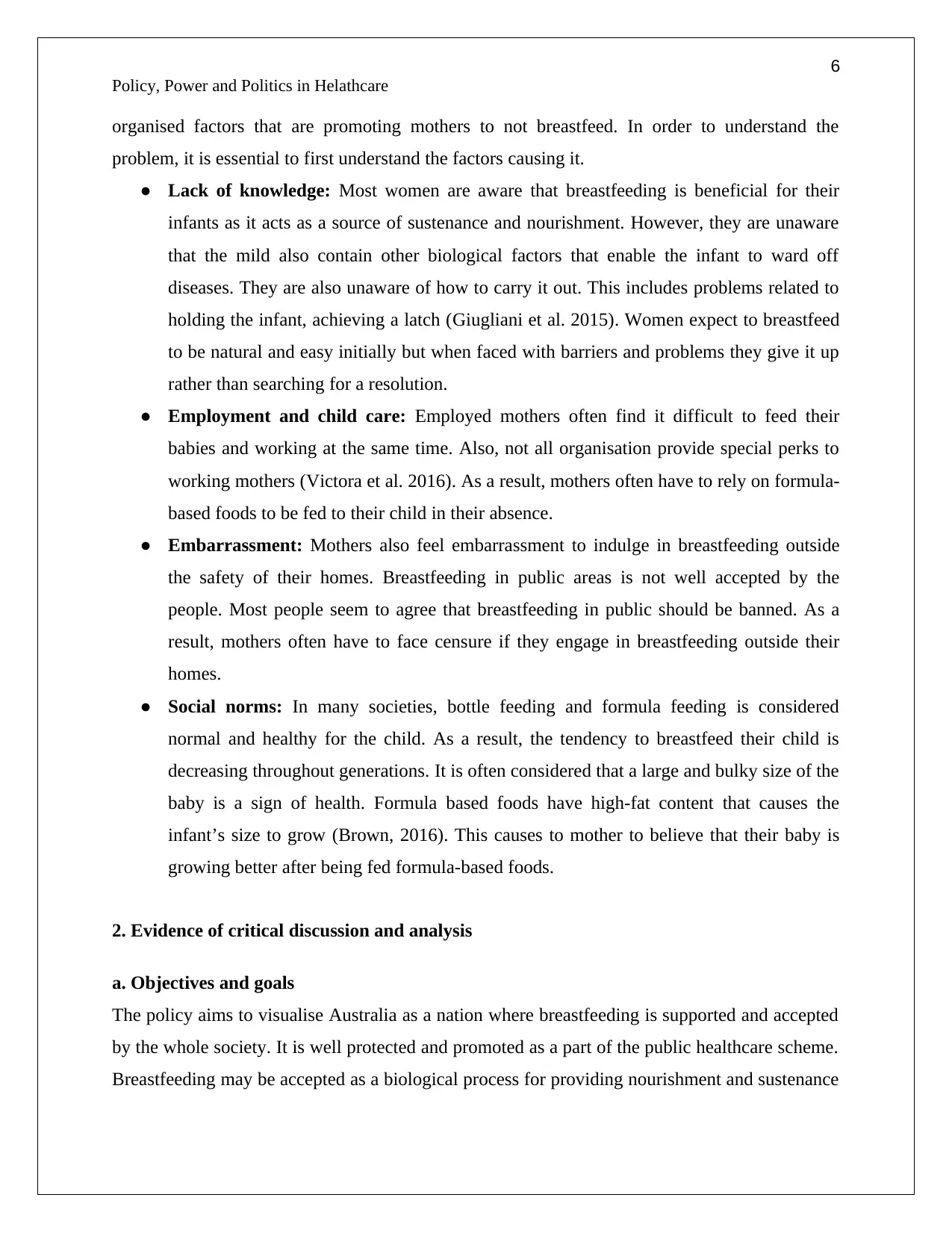
6
Policy, Power and Politics in Helathcare
organised factors that are promoting mothers to not breastfeed. In order to understand the
problem, it is essential to first understand the factors causing it.
● Lack of knowledge: Most women are aware that breastfeeding is beneficial for their
infants as it acts as a source of sustenance and nourishment. However, they are unaware
that the mild also contain other biological factors that enable the infant to ward off
diseases. They are also unaware of how to carry it out. This includes problems related to
holding the infant, achieving a latch (Giugliani et al. 2015). Women expect to breastfeed
to be natural and easy initially but when faced with barriers and problems they give it up
rather than searching for a resolution.
● Employment and child care: Employed mothers often find it difficult to feed their
babies and working at the same time. Also, not all organisation provide special perks to
working mothers (Victora et al. 2016). As a result, mothers often have to rely on formula-
based foods to be fed to their child in their absence.
● Embarrassment: Mothers also feel embarrassment to indulge in breastfeeding outside
the safety of their homes. Breastfeeding in public areas is not well accepted by the
people. Most people seem to agree that breastfeeding in public should be banned. As a
result, mothers often have to face censure if they engage in breastfeeding outside their
homes.
● Social norms: In many societies, bottle feeding and formula feeding is considered
normal and healthy for the child. As a result, the tendency to breastfeed their child is
decreasing throughout generations. It is often considered that a large and bulky size of the
baby is a sign of health. Formula based foods have high-fat content that causes the
infant’s size to grow (Brown, 2016). This causes to mother to believe that their baby is
growing better after being fed formula-based foods.
2. Evidence of critical discussion and analysis
a. Objectives and goals
The policy aims to visualise Australia as a nation where breastfeeding is supported and accepted
by the whole society. It is well protected and promoted as a part of the public healthcare scheme.
Breastfeeding may be accepted as a biological process for providing nourishment and sustenance
Policy, Power and Politics in Helathcare
organised factors that are promoting mothers to not breastfeed. In order to understand the
problem, it is essential to first understand the factors causing it.
● Lack of knowledge: Most women are aware that breastfeeding is beneficial for their
infants as it acts as a source of sustenance and nourishment. However, they are unaware
that the mild also contain other biological factors that enable the infant to ward off
diseases. They are also unaware of how to carry it out. This includes problems related to
holding the infant, achieving a latch (Giugliani et al. 2015). Women expect to breastfeed
to be natural and easy initially but when faced with barriers and problems they give it up
rather than searching for a resolution.
● Employment and child care: Employed mothers often find it difficult to feed their
babies and working at the same time. Also, not all organisation provide special perks to
working mothers (Victora et al. 2016). As a result, mothers often have to rely on formula-
based foods to be fed to their child in their absence.
● Embarrassment: Mothers also feel embarrassment to indulge in breastfeeding outside
the safety of their homes. Breastfeeding in public areas is not well accepted by the
people. Most people seem to agree that breastfeeding in public should be banned. As a
result, mothers often have to face censure if they engage in breastfeeding outside their
homes.
● Social norms: In many societies, bottle feeding and formula feeding is considered
normal and healthy for the child. As a result, the tendency to breastfeed their child is
decreasing throughout generations. It is often considered that a large and bulky size of the
baby is a sign of health. Formula based foods have high-fat content that causes the
infant’s size to grow (Brown, 2016). This causes to mother to believe that their baby is
growing better after being fed formula-based foods.
2. Evidence of critical discussion and analysis
a. Objectives and goals
The policy aims to visualise Australia as a nation where breastfeeding is supported and accepted
by the whole society. It is well protected and promoted as a part of the public healthcare scheme.
Breastfeeding may be accepted as a biological process for providing nourishment and sustenance
Paraphrase This Document
Need a fresh take? Get an instant paraphrase of this document with our AI Paraphraser
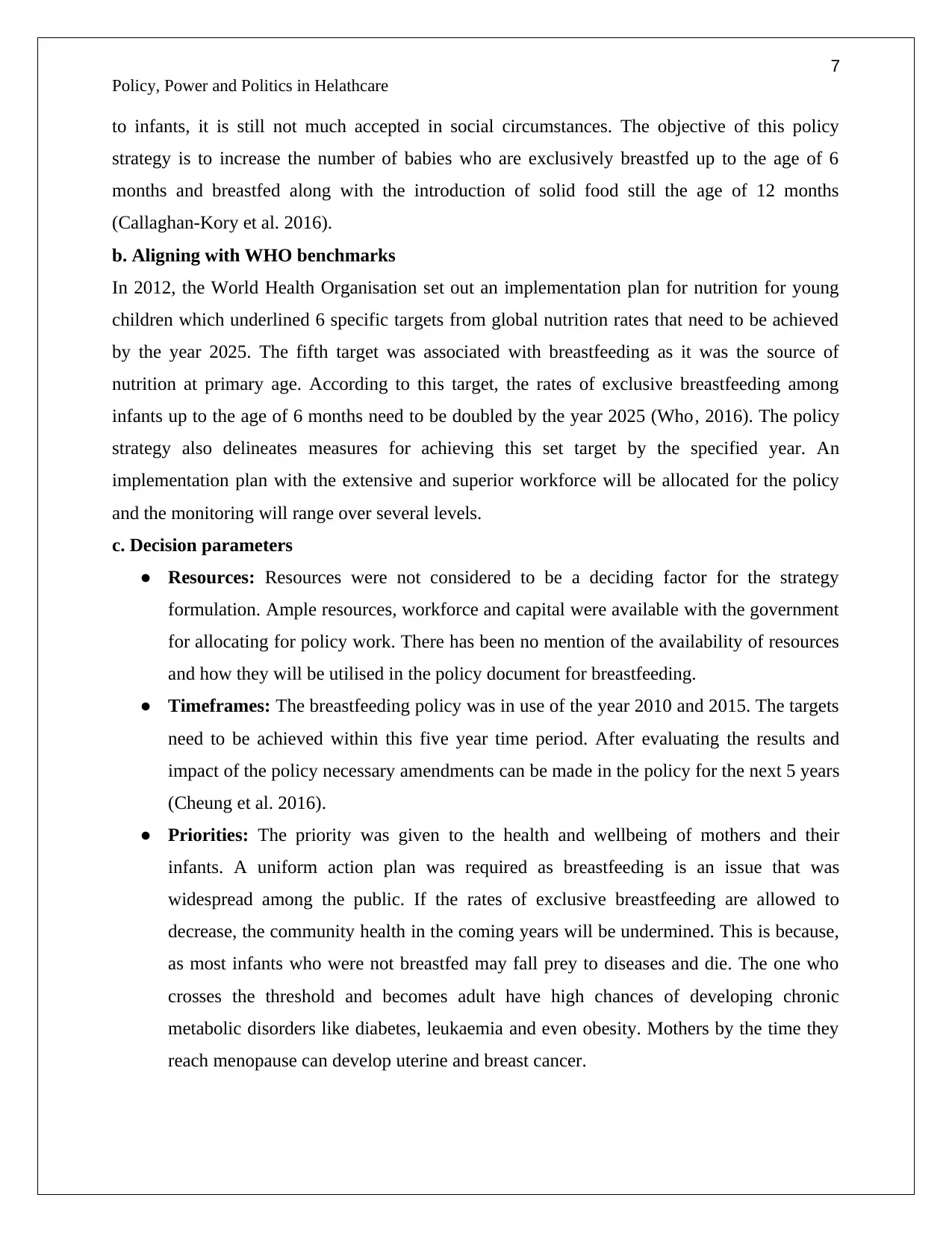
7
Policy, Power and Politics in Helathcare
to infants, it is still not much accepted in social circumstances. The objective of this policy
strategy is to increase the number of babies who are exclusively breastfed up to the age of 6
months and breastfed along with the introduction of solid food still the age of 12 months
(Callaghan-Kory et al. 2016).
b. Aligning with WHO benchmarks
In 2012, the World Health Organisation set out an implementation plan for nutrition for young
children which underlined 6 specific targets from global nutrition rates that need to be achieved
by the year 2025. The fifth target was associated with breastfeeding as it was the source of
nutrition at primary age. According to this target, the rates of exclusive breastfeeding among
infants up to the age of 6 months need to be doubled by the year 2025 (Who, 2016). The policy
strategy also delineates measures for achieving this set target by the specified year. An
implementation plan with the extensive and superior workforce will be allocated for the policy
and the monitoring will range over several levels.
c. Decision parameters
● Resources: Resources were not considered to be a deciding factor for the strategy
formulation. Ample resources, workforce and capital were available with the government
for allocating for policy work. There has been no mention of the availability of resources
and how they will be utilised in the policy document for breastfeeding.
● Timeframes: The breastfeeding policy was in use of the year 2010 and 2015. The targets
need to be achieved within this five year time period. After evaluating the results and
impact of the policy necessary amendments can be made in the policy for the next 5 years
(Cheung et al. 2016).
● Priorities: The priority was given to the health and wellbeing of mothers and their
infants. A uniform action plan was required as breastfeeding is an issue that was
widespread among the public. If the rates of exclusive breastfeeding are allowed to
decrease, the community health in the coming years will be undermined. This is because,
as most infants who were not breastfed may fall prey to diseases and die. The one who
crosses the threshold and becomes adult have high chances of developing chronic
metabolic disorders like diabetes, leukaemia and even obesity. Mothers by the time they
reach menopause can develop uterine and breast cancer.
Policy, Power and Politics in Helathcare
to infants, it is still not much accepted in social circumstances. The objective of this policy
strategy is to increase the number of babies who are exclusively breastfed up to the age of 6
months and breastfed along with the introduction of solid food still the age of 12 months
(Callaghan-Kory et al. 2016).
b. Aligning with WHO benchmarks
In 2012, the World Health Organisation set out an implementation plan for nutrition for young
children which underlined 6 specific targets from global nutrition rates that need to be achieved
by the year 2025. The fifth target was associated with breastfeeding as it was the source of
nutrition at primary age. According to this target, the rates of exclusive breastfeeding among
infants up to the age of 6 months need to be doubled by the year 2025 (Who, 2016). The policy
strategy also delineates measures for achieving this set target by the specified year. An
implementation plan with the extensive and superior workforce will be allocated for the policy
and the monitoring will range over several levels.
c. Decision parameters
● Resources: Resources were not considered to be a deciding factor for the strategy
formulation. Ample resources, workforce and capital were available with the government
for allocating for policy work. There has been no mention of the availability of resources
and how they will be utilised in the policy document for breastfeeding.
● Timeframes: The breastfeeding policy was in use of the year 2010 and 2015. The targets
need to be achieved within this five year time period. After evaluating the results and
impact of the policy necessary amendments can be made in the policy for the next 5 years
(Cheung et al. 2016).
● Priorities: The priority was given to the health and wellbeing of mothers and their
infants. A uniform action plan was required as breastfeeding is an issue that was
widespread among the public. If the rates of exclusive breastfeeding are allowed to
decrease, the community health in the coming years will be undermined. This is because,
as most infants who were not breastfed may fall prey to diseases and die. The one who
crosses the threshold and becomes adult have high chances of developing chronic
metabolic disorders like diabetes, leukaemia and even obesity. Mothers by the time they
reach menopause can develop uterine and breast cancer.
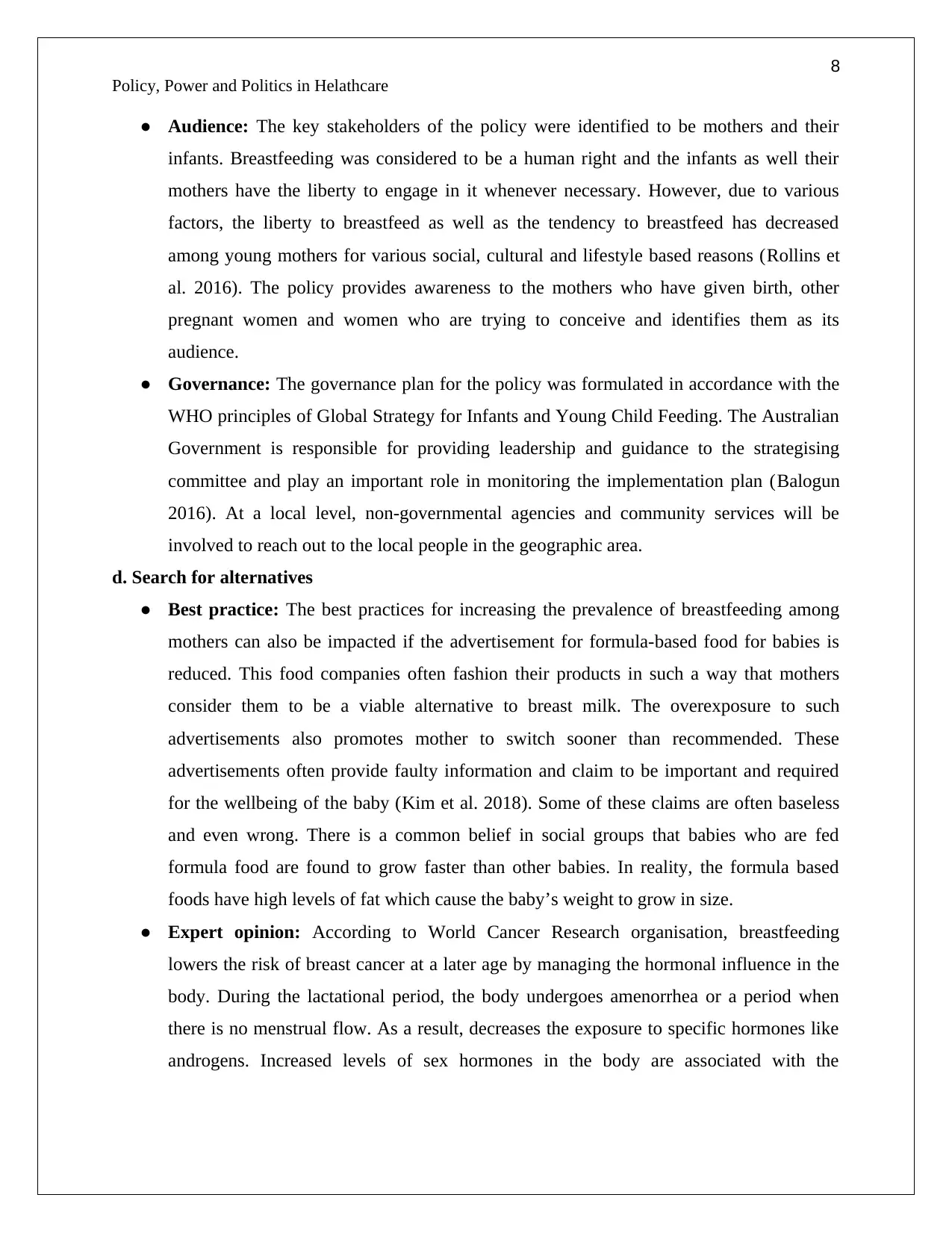
8
Policy, Power and Politics in Helathcare
● Audience: The key stakeholders of the policy were identified to be mothers and their
infants. Breastfeeding was considered to be a human right and the infants as well their
mothers have the liberty to engage in it whenever necessary. However, due to various
factors, the liberty to breastfeed as well as the tendency to breastfeed has decreased
among young mothers for various social, cultural and lifestyle based reasons (Rollins et
al. 2016). The policy provides awareness to the mothers who have given birth, other
pregnant women and women who are trying to conceive and identifies them as its
audience.
● Governance: The governance plan for the policy was formulated in accordance with the
WHO principles of Global Strategy for Infants and Young Child Feeding. The Australian
Government is responsible for providing leadership and guidance to the strategising
committee and play an important role in monitoring the implementation plan (Balogun
2016). At a local level, non-governmental agencies and community services will be
involved to reach out to the local people in the geographic area.
d. Search for alternatives
● Best practice: The best practices for increasing the prevalence of breastfeeding among
mothers can also be impacted if the advertisement for formula-based food for babies is
reduced. This food companies often fashion their products in such a way that mothers
consider them to be a viable alternative to breast milk. The overexposure to such
advertisements also promotes mother to switch sooner than recommended. These
advertisements often provide faulty information and claim to be important and required
for the wellbeing of the baby (Kim et al. 2018). Some of these claims are often baseless
and even wrong. There is a common belief in social groups that babies who are fed
formula food are found to grow faster than other babies. In reality, the formula based
foods have high levels of fat which cause the baby’s weight to grow in size.
● Expert opinion: According to World Cancer Research organisation, breastfeeding
lowers the risk of breast cancer at a later age by managing the hormonal influence in the
body. During the lactational period, the body undergoes amenorrhea or a period when
there is no menstrual flow. As a result, decreases the exposure to specific hormones like
androgens. Increased levels of sex hormones in the body are associated with the
Policy, Power and Politics in Helathcare
● Audience: The key stakeholders of the policy were identified to be mothers and their
infants. Breastfeeding was considered to be a human right and the infants as well their
mothers have the liberty to engage in it whenever necessary. However, due to various
factors, the liberty to breastfeed as well as the tendency to breastfeed has decreased
among young mothers for various social, cultural and lifestyle based reasons (Rollins et
al. 2016). The policy provides awareness to the mothers who have given birth, other
pregnant women and women who are trying to conceive and identifies them as its
audience.
● Governance: The governance plan for the policy was formulated in accordance with the
WHO principles of Global Strategy for Infants and Young Child Feeding. The Australian
Government is responsible for providing leadership and guidance to the strategising
committee and play an important role in monitoring the implementation plan (Balogun
2016). At a local level, non-governmental agencies and community services will be
involved to reach out to the local people in the geographic area.
d. Search for alternatives
● Best practice: The best practices for increasing the prevalence of breastfeeding among
mothers can also be impacted if the advertisement for formula-based food for babies is
reduced. This food companies often fashion their products in such a way that mothers
consider them to be a viable alternative to breast milk. The overexposure to such
advertisements also promotes mother to switch sooner than recommended. These
advertisements often provide faulty information and claim to be important and required
for the wellbeing of the baby (Kim et al. 2018). Some of these claims are often baseless
and even wrong. There is a common belief in social groups that babies who are fed
formula food are found to grow faster than other babies. In reality, the formula based
foods have high levels of fat which cause the baby’s weight to grow in size.
● Expert opinion: According to World Cancer Research organisation, breastfeeding
lowers the risk of breast cancer at a later age by managing the hormonal influence in the
body. During the lactational period, the body undergoes amenorrhea or a period when
there is no menstrual flow. As a result, decreases the exposure to specific hormones like
androgens. Increased levels of sex hormones in the body are associated with the
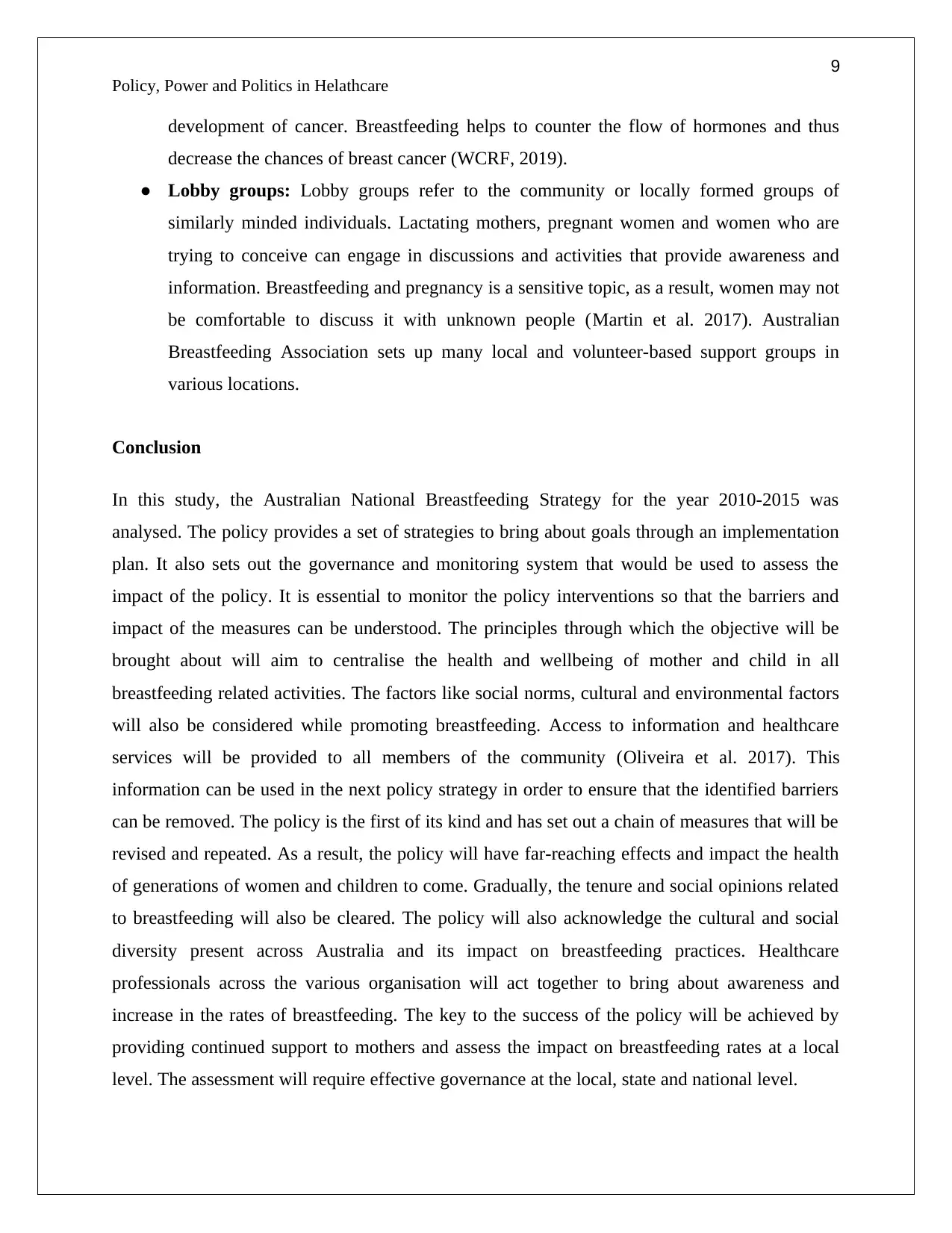
9
Policy, Power and Politics in Helathcare
development of cancer. Breastfeeding helps to counter the flow of hormones and thus
decrease the chances of breast cancer (WCRF, 2019).
● Lobby groups: Lobby groups refer to the community or locally formed groups of
similarly minded individuals. Lactating mothers, pregnant women and women who are
trying to conceive can engage in discussions and activities that provide awareness and
information. Breastfeeding and pregnancy is a sensitive topic, as a result, women may not
be comfortable to discuss it with unknown people (Martin et al. 2017). Australian
Breastfeeding Association sets up many local and volunteer-based support groups in
various locations.
Conclusion
In this study, the Australian National Breastfeeding Strategy for the year 2010-2015 was
analysed. The policy provides a set of strategies to bring about goals through an implementation
plan. It also sets out the governance and monitoring system that would be used to assess the
impact of the policy. It is essential to monitor the policy interventions so that the barriers and
impact of the measures can be understood. The principles through which the objective will be
brought about will aim to centralise the health and wellbeing of mother and child in all
breastfeeding related activities. The factors like social norms, cultural and environmental factors
will also be considered while promoting breastfeeding. Access to information and healthcare
services will be provided to all members of the community (Oliveira et al. 2017). This
information can be used in the next policy strategy in order to ensure that the identified barriers
can be removed. The policy is the first of its kind and has set out a chain of measures that will be
revised and repeated. As a result, the policy will have far-reaching effects and impact the health
of generations of women and children to come. Gradually, the tenure and social opinions related
to breastfeeding will also be cleared. The policy will also acknowledge the cultural and social
diversity present across Australia and its impact on breastfeeding practices. Healthcare
professionals across the various organisation will act together to bring about awareness and
increase in the rates of breastfeeding. The key to the success of the policy will be achieved by
providing continued support to mothers and assess the impact on breastfeeding rates at a local
level. The assessment will require effective governance at the local, state and national level.
Policy, Power and Politics in Helathcare
development of cancer. Breastfeeding helps to counter the flow of hormones and thus
decrease the chances of breast cancer (WCRF, 2019).
● Lobby groups: Lobby groups refer to the community or locally formed groups of
similarly minded individuals. Lactating mothers, pregnant women and women who are
trying to conceive can engage in discussions and activities that provide awareness and
information. Breastfeeding and pregnancy is a sensitive topic, as a result, women may not
be comfortable to discuss it with unknown people (Martin et al. 2017). Australian
Breastfeeding Association sets up many local and volunteer-based support groups in
various locations.
Conclusion
In this study, the Australian National Breastfeeding Strategy for the year 2010-2015 was
analysed. The policy provides a set of strategies to bring about goals through an implementation
plan. It also sets out the governance and monitoring system that would be used to assess the
impact of the policy. It is essential to monitor the policy interventions so that the barriers and
impact of the measures can be understood. The principles through which the objective will be
brought about will aim to centralise the health and wellbeing of mother and child in all
breastfeeding related activities. The factors like social norms, cultural and environmental factors
will also be considered while promoting breastfeeding. Access to information and healthcare
services will be provided to all members of the community (Oliveira et al. 2017). This
information can be used in the next policy strategy in order to ensure that the identified barriers
can be removed. The policy is the first of its kind and has set out a chain of measures that will be
revised and repeated. As a result, the policy will have far-reaching effects and impact the health
of generations of women and children to come. Gradually, the tenure and social opinions related
to breastfeeding will also be cleared. The policy will also acknowledge the cultural and social
diversity present across Australia and its impact on breastfeeding practices. Healthcare
professionals across the various organisation will act together to bring about awareness and
increase in the rates of breastfeeding. The key to the success of the policy will be achieved by
providing continued support to mothers and assess the impact on breastfeeding rates at a local
level. The assessment will require effective governance at the local, state and national level.
Secure Best Marks with AI Grader
Need help grading? Try our AI Grader for instant feedback on your assignments.
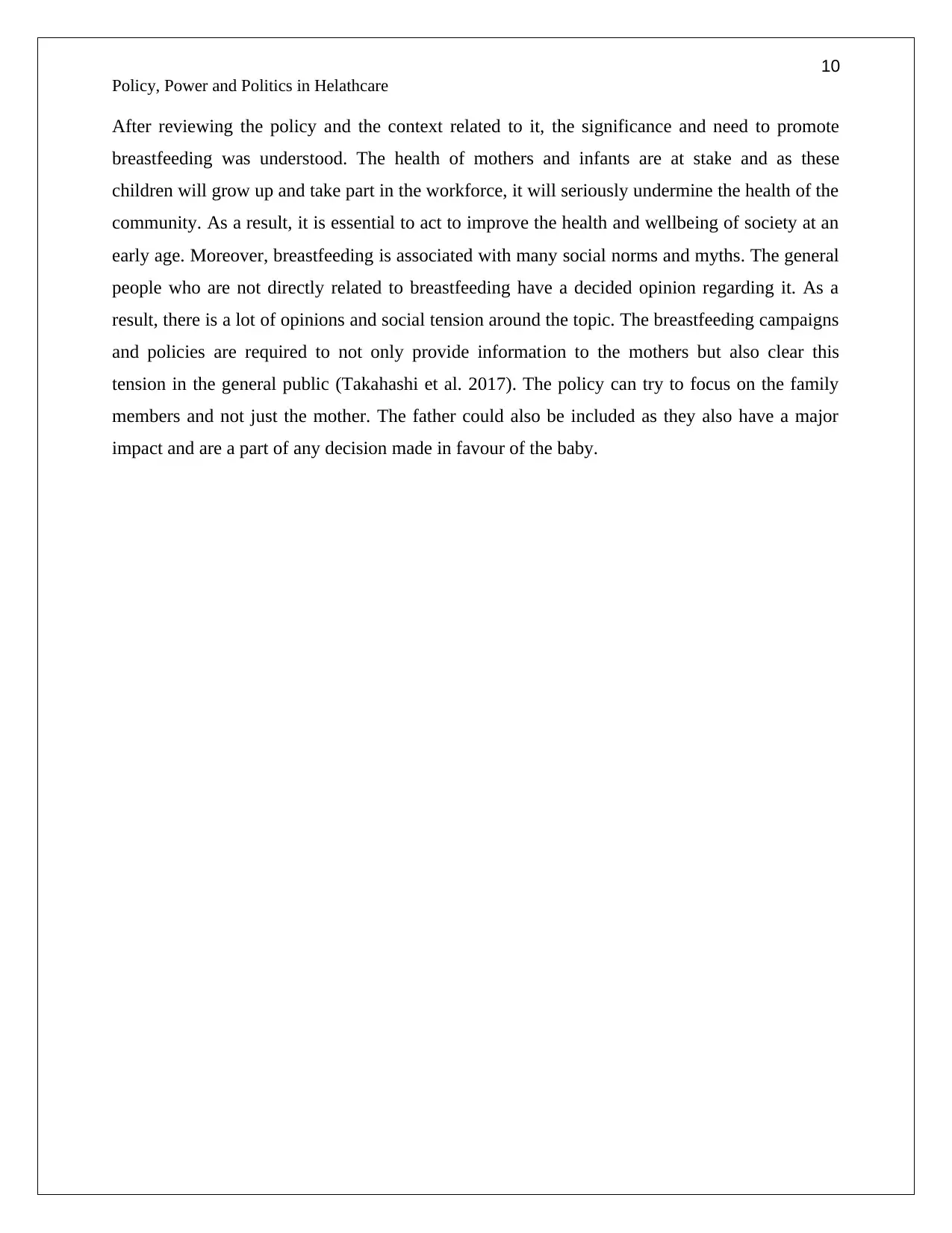
10
Policy, Power and Politics in Helathcare
After reviewing the policy and the context related to it, the significance and need to promote
breastfeeding was understood. The health of mothers and infants are at stake and as these
children will grow up and take part in the workforce, it will seriously undermine the health of the
community. As a result, it is essential to act to improve the health and wellbeing of society at an
early age. Moreover, breastfeeding is associated with many social norms and myths. The general
people who are not directly related to breastfeeding have a decided opinion regarding it. As a
result, there is a lot of opinions and social tension around the topic. The breastfeeding campaigns
and policies are required to not only provide information to the mothers but also clear this
tension in the general public (Takahashi et al. 2017). The policy can try to focus on the family
members and not just the mother. The father could also be included as they also have a major
impact and are a part of any decision made in favour of the baby.
Policy, Power and Politics in Helathcare
After reviewing the policy and the context related to it, the significance and need to promote
breastfeeding was understood. The health of mothers and infants are at stake and as these
children will grow up and take part in the workforce, it will seriously undermine the health of the
community. As a result, it is essential to act to improve the health and wellbeing of society at an
early age. Moreover, breastfeeding is associated with many social norms and myths. The general
people who are not directly related to breastfeeding have a decided opinion regarding it. As a
result, there is a lot of opinions and social tension around the topic. The breastfeeding campaigns
and policies are required to not only provide information to the mothers but also clear this
tension in the general public (Takahashi et al. 2017). The policy can try to focus on the family
members and not just the mother. The father could also be included as they also have a major
impact and are a part of any decision made in favour of the baby.
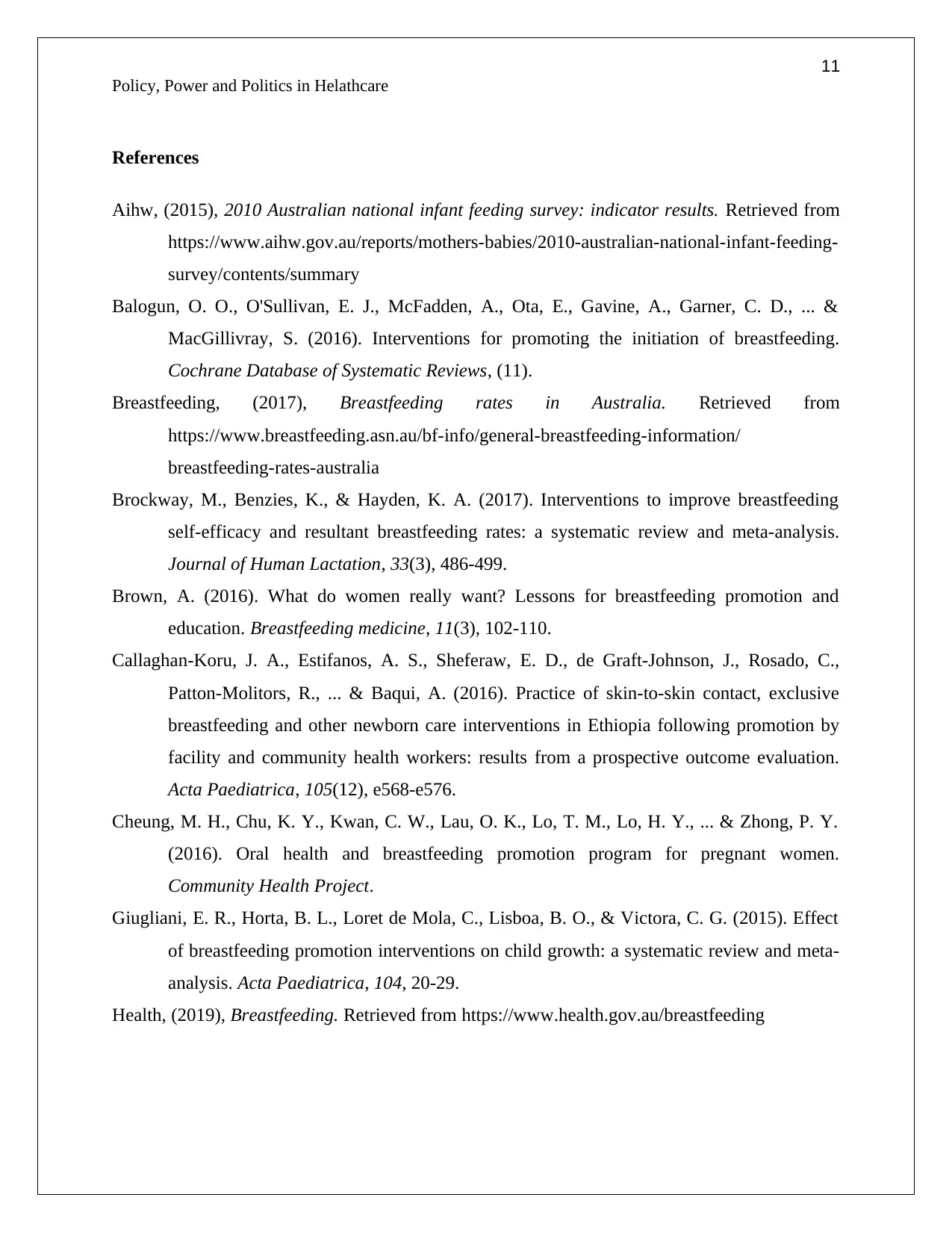
11
Policy, Power and Politics in Helathcare
References
Aihw, (2015), 2010 Australian national infant feeding survey: indicator results. Retrieved from
https://www.aihw.gov.au/reports/mothers-babies/2010-australian-national-infant-feeding-
survey/contents/summary
Balogun, O. O., O'Sullivan, E. J., McFadden, A., Ota, E., Gavine, A., Garner, C. D., ... &
MacGillivray, S. (2016). Interventions for promoting the initiation of breastfeeding.
Cochrane Database of Systematic Reviews, (11).
Breastfeeding, (2017), Breastfeeding rates in Australia. Retrieved from
https://www.breastfeeding.asn.au/bf-info/general-breastfeeding-information/
breastfeeding-rates-australia
Brockway, M., Benzies, K., & Hayden, K. A. (2017). Interventions to improve breastfeeding
self-efficacy and resultant breastfeeding rates: a systematic review and meta-analysis.
Journal of Human Lactation, 33(3), 486-499.
Brown, A. (2016). What do women really want? Lessons for breastfeeding promotion and
education. Breastfeeding medicine, 11(3), 102-110.
Callaghan‐Koru, J. A., Estifanos, A. S., Sheferaw, E. D., de Graft‐Johnson, J., Rosado, C.,
Patton‐Molitors, R., ... & Baqui, A. (2016). Practice of skin‐to‐skin contact, exclusive
breastfeeding and other newborn care interventions in Ethiopia following promotion by
facility and community health workers: results from a prospective outcome evaluation.
Acta Paediatrica, 105(12), e568-e576.
Cheung, M. H., Chu, K. Y., Kwan, C. W., Lau, O. K., Lo, T. M., Lo, H. Y., ... & Zhong, P. Y.
(2016). Oral health and breastfeeding promotion program for pregnant women.
Community Health Project.
Giugliani, E. R., Horta, B. L., Loret de Mola, C., Lisboa, B. O., & Victora, C. G. (2015). Effect
of breastfeeding promotion interventions on child growth: a systematic review and meta‐
analysis. Acta Paediatrica, 104, 20-29.
Health, (2019), Breastfeeding. Retrieved from https://www.health.gov.au/breastfeeding
Policy, Power and Politics in Helathcare
References
Aihw, (2015), 2010 Australian national infant feeding survey: indicator results. Retrieved from
https://www.aihw.gov.au/reports/mothers-babies/2010-australian-national-infant-feeding-
survey/contents/summary
Balogun, O. O., O'Sullivan, E. J., McFadden, A., Ota, E., Gavine, A., Garner, C. D., ... &
MacGillivray, S. (2016). Interventions for promoting the initiation of breastfeeding.
Cochrane Database of Systematic Reviews, (11).
Breastfeeding, (2017), Breastfeeding rates in Australia. Retrieved from
https://www.breastfeeding.asn.au/bf-info/general-breastfeeding-information/
breastfeeding-rates-australia
Brockway, M., Benzies, K., & Hayden, K. A. (2017). Interventions to improve breastfeeding
self-efficacy and resultant breastfeeding rates: a systematic review and meta-analysis.
Journal of Human Lactation, 33(3), 486-499.
Brown, A. (2016). What do women really want? Lessons for breastfeeding promotion and
education. Breastfeeding medicine, 11(3), 102-110.
Callaghan‐Koru, J. A., Estifanos, A. S., Sheferaw, E. D., de Graft‐Johnson, J., Rosado, C.,
Patton‐Molitors, R., ... & Baqui, A. (2016). Practice of skin‐to‐skin contact, exclusive
breastfeeding and other newborn care interventions in Ethiopia following promotion by
facility and community health workers: results from a prospective outcome evaluation.
Acta Paediatrica, 105(12), e568-e576.
Cheung, M. H., Chu, K. Y., Kwan, C. W., Lau, O. K., Lo, T. M., Lo, H. Y., ... & Zhong, P. Y.
(2016). Oral health and breastfeeding promotion program for pregnant women.
Community Health Project.
Giugliani, E. R., Horta, B. L., Loret de Mola, C., Lisboa, B. O., & Victora, C. G. (2015). Effect
of breastfeeding promotion interventions on child growth: a systematic review and meta‐
analysis. Acta Paediatrica, 104, 20-29.
Health, (2019), Breastfeeding. Retrieved from https://www.health.gov.au/breastfeeding
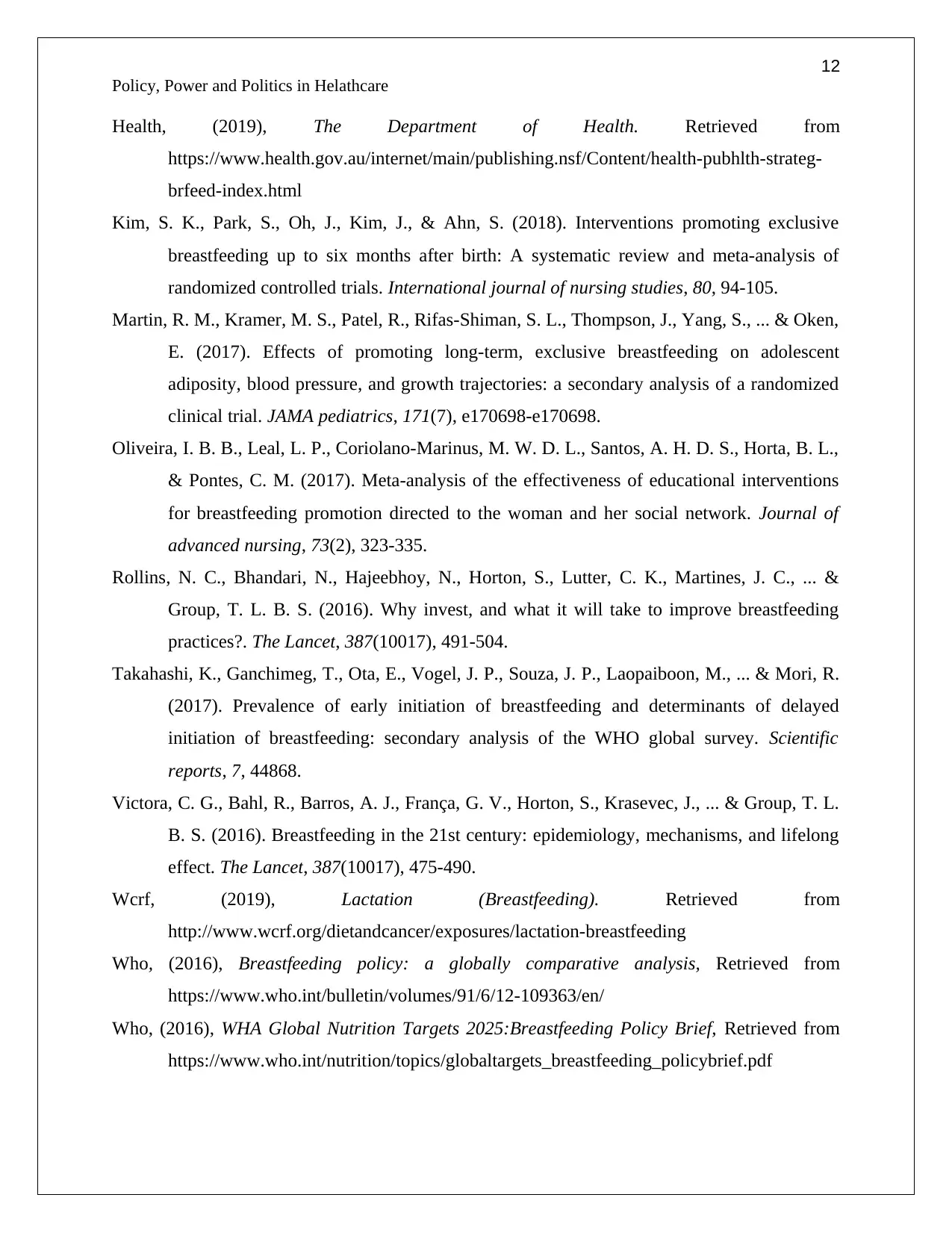
12
Policy, Power and Politics in Helathcare
Health, (2019), The Department of Health. Retrieved from
https://www.health.gov.au/internet/main/publishing.nsf/Content/health-pubhlth-strateg-
brfeed-index.html
Kim, S. K., Park, S., Oh, J., Kim, J., & Ahn, S. (2018). Interventions promoting exclusive
breastfeeding up to six months after birth: A systematic review and meta-analysis of
randomized controlled trials. International journal of nursing studies, 80, 94-105.
Martin, R. M., Kramer, M. S., Patel, R., Rifas-Shiman, S. L., Thompson, J., Yang, S., ... & Oken,
E. (2017). Effects of promoting long-term, exclusive breastfeeding on adolescent
adiposity, blood pressure, and growth trajectories: a secondary analysis of a randomized
clinical trial. JAMA pediatrics, 171(7), e170698-e170698.
Oliveira, I. B. B., Leal, L. P., Coriolano‐Marinus, M. W. D. L., Santos, A. H. D. S., Horta, B. L.,
& Pontes, C. M. (2017). Meta‐analysis of the effectiveness of educational interventions
for breastfeeding promotion directed to the woman and her social network. Journal of
advanced nursing, 73(2), 323-335.
Rollins, N. C., Bhandari, N., Hajeebhoy, N., Horton, S., Lutter, C. K., Martines, J. C., ... &
Group, T. L. B. S. (2016). Why invest, and what it will take to improve breastfeeding
practices?. The Lancet, 387(10017), 491-504.
Takahashi, K., Ganchimeg, T., Ota, E., Vogel, J. P., Souza, J. P., Laopaiboon, M., ... & Mori, R.
(2017). Prevalence of early initiation of breastfeeding and determinants of delayed
initiation of breastfeeding: secondary analysis of the WHO global survey. Scientific
reports, 7, 44868.
Victora, C. G., Bahl, R., Barros, A. J., França, G. V., Horton, S., Krasevec, J., ... & Group, T. L.
B. S. (2016). Breastfeeding in the 21st century: epidemiology, mechanisms, and lifelong
effect. The Lancet, 387(10017), 475-490.
Wcrf, (2019), Lactation (Breastfeeding). Retrieved from
http://www.wcrf.org/dietandcancer/exposures/lactation-breastfeeding
Who, (2016), Breastfeeding policy: a globally comparative analysis, Retrieved from
https://www.who.int/bulletin/volumes/91/6/12-109363/en/
Who, (2016), WHA Global Nutrition Targets 2025:Breastfeeding Policy Brief, Retrieved from
https://www.who.int/nutrition/topics/globaltargets_breastfeeding_policybrief.pdf
Policy, Power and Politics in Helathcare
Health, (2019), The Department of Health. Retrieved from
https://www.health.gov.au/internet/main/publishing.nsf/Content/health-pubhlth-strateg-
brfeed-index.html
Kim, S. K., Park, S., Oh, J., Kim, J., & Ahn, S. (2018). Interventions promoting exclusive
breastfeeding up to six months after birth: A systematic review and meta-analysis of
randomized controlled trials. International journal of nursing studies, 80, 94-105.
Martin, R. M., Kramer, M. S., Patel, R., Rifas-Shiman, S. L., Thompson, J., Yang, S., ... & Oken,
E. (2017). Effects of promoting long-term, exclusive breastfeeding on adolescent
adiposity, blood pressure, and growth trajectories: a secondary analysis of a randomized
clinical trial. JAMA pediatrics, 171(7), e170698-e170698.
Oliveira, I. B. B., Leal, L. P., Coriolano‐Marinus, M. W. D. L., Santos, A. H. D. S., Horta, B. L.,
& Pontes, C. M. (2017). Meta‐analysis of the effectiveness of educational interventions
for breastfeeding promotion directed to the woman and her social network. Journal of
advanced nursing, 73(2), 323-335.
Rollins, N. C., Bhandari, N., Hajeebhoy, N., Horton, S., Lutter, C. K., Martines, J. C., ... &
Group, T. L. B. S. (2016). Why invest, and what it will take to improve breastfeeding
practices?. The Lancet, 387(10017), 491-504.
Takahashi, K., Ganchimeg, T., Ota, E., Vogel, J. P., Souza, J. P., Laopaiboon, M., ... & Mori, R.
(2017). Prevalence of early initiation of breastfeeding and determinants of delayed
initiation of breastfeeding: secondary analysis of the WHO global survey. Scientific
reports, 7, 44868.
Victora, C. G., Bahl, R., Barros, A. J., França, G. V., Horton, S., Krasevec, J., ... & Group, T. L.
B. S. (2016). Breastfeeding in the 21st century: epidemiology, mechanisms, and lifelong
effect. The Lancet, 387(10017), 475-490.
Wcrf, (2019), Lactation (Breastfeeding). Retrieved from
http://www.wcrf.org/dietandcancer/exposures/lactation-breastfeeding
Who, (2016), Breastfeeding policy: a globally comparative analysis, Retrieved from
https://www.who.int/bulletin/volumes/91/6/12-109363/en/
Who, (2016), WHA Global Nutrition Targets 2025:Breastfeeding Policy Brief, Retrieved from
https://www.who.int/nutrition/topics/globaltargets_breastfeeding_policybrief.pdf
Paraphrase This Document
Need a fresh take? Get an instant paraphrase of this document with our AI Paraphraser
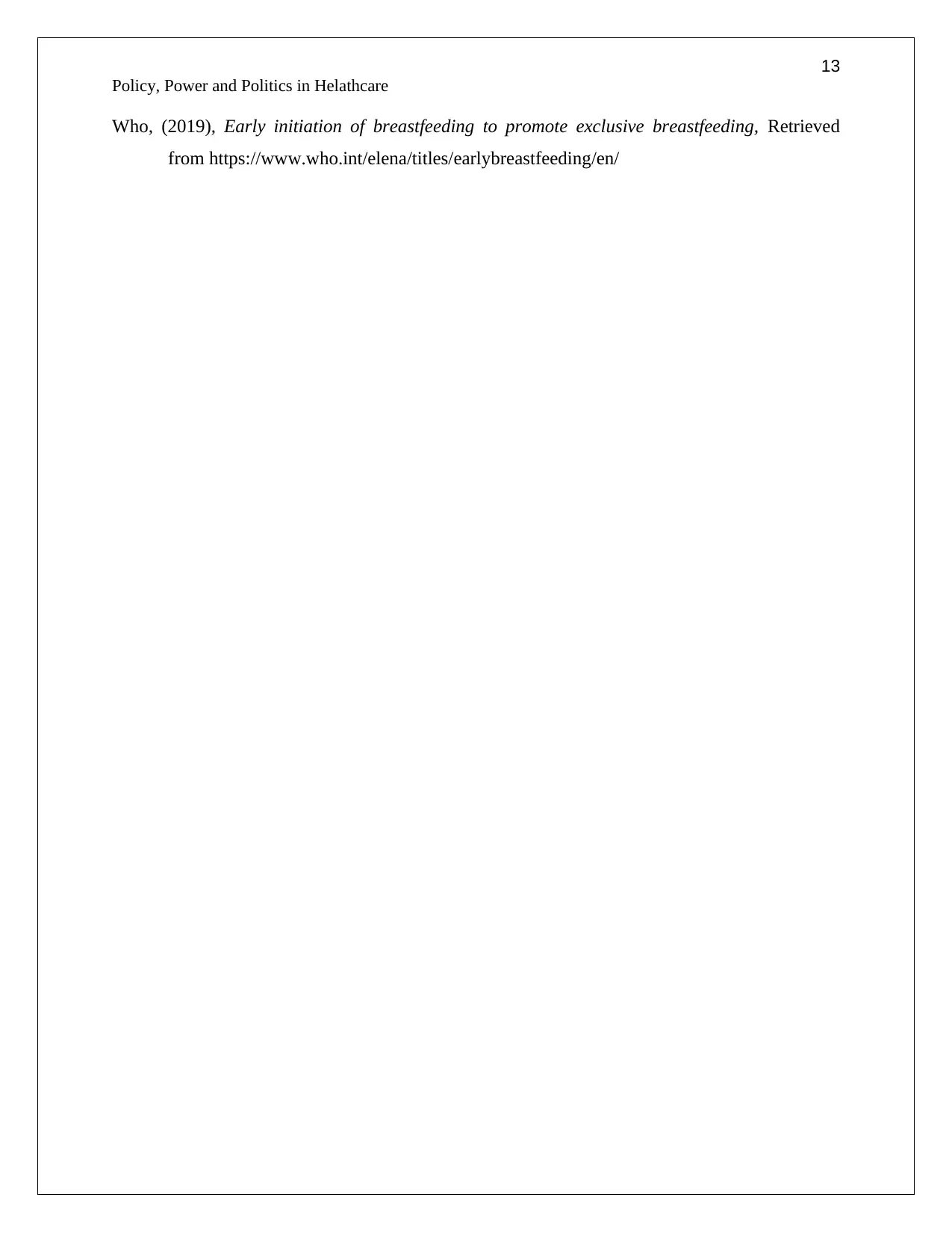
13
Policy, Power and Politics in Helathcare
Who, (2019), Early initiation of breastfeeding to promote exclusive breastfeeding, Retrieved
from https://www.who.int/elena/titles/earlybreastfeeding/en/
Policy, Power and Politics in Helathcare
Who, (2019), Early initiation of breastfeeding to promote exclusive breastfeeding, Retrieved
from https://www.who.int/elena/titles/earlybreastfeeding/en/
1 out of 14
Related Documents
Your All-in-One AI-Powered Toolkit for Academic Success.
+13062052269
info@desklib.com
Available 24*7 on WhatsApp / Email
![[object Object]](/_next/static/media/star-bottom.7253800d.svg)
Unlock your academic potential
© 2024 | Zucol Services PVT LTD | All rights reserved.





